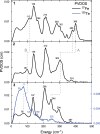125Te and 57Fe nuclear resonance vibrational spectroscopic characterization of intermediate spin state mixed-valent dimers
- PMID: 40715092
- PMCID: PMC12297287
- DOI: 10.1038/s41467-025-62118-w
125Te and 57Fe nuclear resonance vibrational spectroscopic characterization of intermediate spin state mixed-valent dimers
Abstract
Iron-sulfur clusters fulfill numerous roles throughout biology. The reduced [2Fe-2S]+ cluster offers unique electronic and magnetic properties due to its mixed-valent nature and can serve as an essential model for understanding electron transfer, electron delocalization, and accessible spin states not only in mixed-valent dimers, but potentially larger iron sulfur clusters. Recently a series of mixed-valent diiron dichalcogenide complexes [L2Fe2Q2]- (Q = S (1), Se (2), Te (3), L = 2,6-diisopropylphenyl β-diketiminate ligand) were synthesized and characterized, where complex 1 showed a typical S = 1/2 spin state, while complexes 2 and 3 exhibited intermediate S = 3/2 spin states, potentially enabled by the minimization of vibronic coupling. Here we studied the vibrational dynamics of the Fe and Te centers in these complexes using 57Fe and 125Te nuclear resonance vibrational spectroscopy (NRVS), coupled with DFT calculations. The findings suggest that heavy character of larger chalcogen atoms results in decreased vibronic coupling. The observation of an intermediate spin state is shown to be unattainable for lighter Fe2Q2 cores. This highlights the crucial role of vibronic coupling in modulating the electronic structure of mixed-valence systems and should enhance understanding of the electronic structure in more complex biological Fe-S clusters.
© 2025. The Author(s).
Conflict of interest statement
Competing interests: The authors declare no competing interests.
Figures





Similar articles
-
Stabilization of intermediate spin states in mixed-valent diiron dichalcogenide complexes.Nat Chem. 2022 Mar;14(3):328-333. doi: 10.1038/s41557-021-00853-5. Epub 2022 Jan 20. Nat Chem. 2022. PMID: 35058610 Free PMC article.
-
Intramolecular Oxo Atom Migration to the cis Thiolate Sulfur of an Fe-Oxo Intermediate.J Am Chem Soc. 2025 Jul 23;147(29):25337-25349. doi: 10.1021/jacs.5c04340. Epub 2025 Jul 11. J Am Chem Soc. 2025. PMID: 40644318
-
Automated devices for identifying peripheral arterial disease in people with leg ulceration: an evidence synthesis and cost-effectiveness analysis.Health Technol Assess. 2024 Aug;28(37):1-158. doi: 10.3310/TWCG3912. Health Technol Assess. 2024. PMID: 39186036 Free PMC article.
-
Interventions to improve safe and effective medicines use by consumers: an overview of systematic reviews.Cochrane Database Syst Rev. 2014 Apr 29;2014(4):CD007768. doi: 10.1002/14651858.CD007768.pub3. Cochrane Database Syst Rev. 2014. PMID: 24777444 Free PMC article.
-
Management of urinary stones by experts in stone disease (ESD 2025).Arch Ital Urol Androl. 2025 Jun 30;97(2):14085. doi: 10.4081/aiua.2025.14085. Epub 2025 Jun 30. Arch Ital Urol Androl. 2025. PMID: 40583613 Review.
References
-
- Beinert, H., Holm, R. H. & Munck, E. Iron-sulfur clusters: nature’s modular, multipurpose structures. Science277, 653–659 (1997). - PubMed
-
- Solomon, E. I., Xie, X. J. & Dey, A. Mixed valent sites in biological electron transfer. Chem. Soc. Rev.37, 623–638 (2008). - PubMed
-
- Albers, A. et al. The complete characterization of a reduced biomimetic [2Fe-2S] cluster. Angew. Chem. Int. Edit. 50, 9191–9194 (2011). - PubMed
-
- Albers, A., Bayer, T., Demeshko, S., Dechert, S. & Meyer, F. A Functional model for the Rieske center: full characterization of a biomimetic N-Ligated [2Fe-2S] cluster in different protonation states. Chem. Eur. J. 19, 10101–10106 (2013). - PubMed
Grants and funding
LinkOut - more resources
Full Text Sources
Miscellaneous

